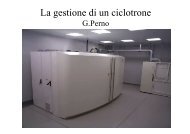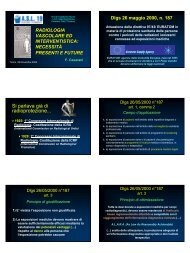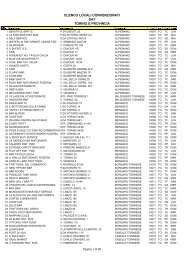THE PIXEL IONIZATION CHAMBER. proceed: submitted to Wo - Infn
THE PIXEL IONIZATION CHAMBER. proceed: submitted to Wo - Infn
THE PIXEL IONIZATION CHAMBER. proceed: submitted to Wo - Infn
Create successful ePaper yourself
Turn your PDF publications into a flip-book with our unique Google optimized e-Paper software.
A SOLUTION FOR DOSIMETRY AND QUALITY<br />
ASSURANCE IN IMRT AND HADRON<strong>THE</strong>RAPY:<br />
<strong>THE</strong> <strong>PIXEL</strong> <strong>IONIZATION</strong> <strong>CHAMBER</strong>.<br />
S. AMERIO, S. CODA, U. NASTASI<br />
Servizio di Fisica Sanitaria, Ospedale S. Giovanni A.S.<br />
V. Cavour 31, I-10123 Torino, Italy<br />
S. BELLETTI, B. GHEDI<br />
Servizio di Fisica Sanitaria, Spedali Civili di Brescia<br />
P.le Ospedale 1, I-25123 Brescia, Italy<br />
A. BORIANO<br />
ASP, V.le Settimio Severo 65, I-10133 Torino, Italy<br />
R. CIRIO, A. LUPARIA, F. MARCHETTO, C. PERONI, C.J. SANZ FREIRE<br />
Università and INFN of Torino, V. Giuria 1, I-10125 Torino, Italy<br />
M. DONETTI<br />
Fondazione TERA, V. Puccini 11, I-28100 Novara, Italy<br />
E-mail: donetti@<strong>to</strong>.infn.it<br />
E. MADON, E. TREVISIOL, A. URGESI<br />
OIRM S. Anna, V. Baiardi 43, I-10126 Torino, Italy<br />
The new radiotherapy techniques require new detec<strong>to</strong>rs <strong>to</strong> moni<strong>to</strong>r and measure<br />
the clinical field. The Intensity Modulated Radiation Therapy (IMRT) techniques<br />
like step and shoot, sliding window, dynamic wedge or scanning beam add the<br />
time variable <strong>to</strong> the treatment field. In this case the water phan<strong>to</strong>m with a single<br />
ionization chamber moving inside the field needs very long measurement time.<br />
Linear arrays of ionization chambers or diodes measure the field only along a line.<br />
2D detec<strong>to</strong>rs like radiographic or gafchromic film are not suitable <strong>to</strong> be used as<br />
on line detec<strong>to</strong>rs. We have developed, built and tested an ionization chamber<br />
segmented in pixels that measure the dose in a plane at several points. Every<br />
channel has a dedicated electronic chain that digitizes the collected charge and data<br />
from all the channels are sent <strong>to</strong> the computer that performs the data acquisition.<br />
One read out cycle is very fast allowing <strong>to</strong> measure in real time the fluency and<br />
the shape of the field. The chamber can be used in two different ways, as moni<strong>to</strong>r<br />
chamber and as relative dosemeter. A description of the detec<strong>to</strong>r, the electronics,<br />
and test results with both pho<strong>to</strong>n and hadron beams will be reported.<br />
<strong>proceed</strong>: <strong>submitted</strong> <strong>to</strong> <strong>Wo</strong>rld Scientific on December 3, 2001 1
1 Introduction<br />
We have built a ionization chamber with the anode segmented in pixels that<br />
measure the dose released in a regular grid of points on a plane. Two different<br />
versions have been built in order <strong>to</strong> fit two different kinds of applications.<br />
Our detec<strong>to</strong>r, in fact, can be used both as moni<strong>to</strong>r chamber and as dosemeter<br />
in a polymethylmethacrylate (PMMA) phan<strong>to</strong>m. When used as a moni<strong>to</strong>r<br />
chamber the water equivalent thickness of the detec<strong>to</strong>r is required <strong>to</strong> be as<br />
small as possible. As a dosemeter for electron and pho<strong>to</strong>n beams it is more<br />
important <strong>to</strong> avoid large dishomogeneity whilst the thickness requirements<br />
can be relaxed.<br />
2 Mechanical description<br />
The pixel chamber is a parallel plate ionization chamber where the anode<br />
is segmented in 1024 pixels and covers a <strong>to</strong>tal area of (24 × 24) cm 2 . The<br />
anode was produced with the printed circuit board technology on a substrate<br />
of 100 µm thick vetronite foil, the cathode instead is an aluminized mylar foil.<br />
The front-end acquisition boards are mounted on the anode support.<br />
mylar frame electronic board<br />
cathode<br />
gap frame<br />
pixel<br />
(a) Thin version -<br />
exploded view<br />
cathode<br />
aluminized mylar foils<br />
anode<br />
(b) Thin<br />
version -<br />
side view<br />
cathode gap layer pixel<br />
electronic board<br />
(c) Thick version -<br />
exploded view<br />
cathode<br />
¦ ¦ § §<br />
§ § ¦ ¦<br />
¡ ¡<br />
¡ ¡<br />
¡ ¡<br />
¢ ¢ £ £<br />
£ £ ¢ ¢<br />
¤ ¤ ¥ ¥<br />
¥ ¥ ¤ ¤<br />
gap layer anode<br />
PMMA layers<br />
(d) Thick<br />
version -<br />
side view<br />
Figure 1. Schematic view of the detec<strong>to</strong>r in the thin and thick versions.<br />
The chamber design is characterized by a full modularity: we obtained the<br />
two versions by simply modifying the assembly. In figures 1(a) and1(b) it is<br />
shown an exploded and a side view of the moni<strong>to</strong>r chamber (thin version).<br />
<strong>proceed</strong>: <strong>submitted</strong> <strong>to</strong> <strong>Wo</strong>rld Scientific on December 3, 2001 2
Anode and cathode are glued <strong>to</strong> vetronite frames and the gas gap is defined by<br />
the thickness of another frame placed between the anode and the cathode. In<br />
application where the amount of material along the beam is not a constraint<br />
but only the density of the material (dosemeter in PMMA phan<strong>to</strong>m) anode<br />
and cathode are glued <strong>to</strong> PMMA slabs few millimeters thick. In figures 1(c)<br />
and 1(d) it is shown the views of the detec<strong>to</strong>r (thick version). Between anode<br />
and cathode a plastic slab with a grid of holes is mounted. Every hole<br />
corresponds exactly <strong>to</strong> a pixel, creating an independent sensitive volume.<br />
3 Front-end electronics<br />
The front-end electronics is based<br />
on a Very Large Scale Integration<br />
CK CK<br />
CK<br />
CK<br />
(VLSI) chip that we have devel-<br />
rst_a rst_d latch sel[0:5]<br />
6<br />
oped(TERA05). The electronics block<br />
I0<br />
i -> f<br />
converter<br />
counter<br />
16<br />
latch<br />
16<br />
diagram is shown in figure 2. TERA05<br />
Vp+<br />
Vp- Vth OTA_ref<br />
has 64 independent channels, each one<br />
16<br />
cs<br />
16<br />
consists of three stages. The first converts<br />
the input current in <strong>to</strong> a pulse<br />
buffer<br />
OUT[0:15]<br />
train which frequency is proportional<br />
<strong>to</strong> the current itself. The charge, which<br />
I 63<br />
i -> f<br />
converter<br />
counter<br />
16<br />
latch<br />
16<br />
one pulse correspond <strong>to</strong>, (charge quantum),<br />
it can be adjusted between 100<br />
<strong>to</strong> 800 fC. The maximum frequency<br />
Figure 2. Block diagram of the VLSI chip.<br />
(5 MHz) limits the maximum current that can be measured: with 800 fC<br />
it is equal <strong>to</strong> 4 µA. In figure 3 current-<strong>to</strong>-<br />
10 2<br />
10 3<br />
10 4<br />
10 5<br />
10 6<br />
10 -11<br />
10 -10<br />
10 -9<br />
10 -8<br />
10 -7<br />
10 -6<br />
0.3<br />
0.2<br />
0.1<br />
0<br />
I (A)<br />
-0.1<br />
-0.2<br />
-0.3<br />
10 -11<br />
10 -10<br />
10 -9<br />
10 -8<br />
10 -7<br />
10 -6<br />
frequency linearity is shown. We remark<br />
that the linearity in a very large range<br />
is better then 1%. In the second stage<br />
the pulses are counted with 16 bits wide<br />
counter. Finally, the last stage is a latch<br />
register that is used <strong>to</strong> s<strong>to</strong>re the output of<br />
the counter just before the read out is per-<br />
I (A)<br />
formed by the data acquisition (DAQ) system.<br />
A multiplexer connects the counter,<br />
selected by the DAQ , <strong>to</strong> the 16 digital<br />
Figure 3. Linearity<br />
frequency converter.<br />
of current-<strong>to</strong>-<br />
output lines. 16 VLSI chips are used <strong>to</strong> acquire all the channels of the ionization<br />
chamber. The read-out frequency is 10 MHz allowing us <strong>to</strong> read the<br />
whole chamber in �100 µs. By reading two channel at the same time and<br />
using a 32 bits wide input port the read out time is reduced <strong>to</strong> �50 µs.<br />
<strong>proceed</strong>: <strong>submitted</strong> <strong>to</strong> <strong>Wo</strong>rld Scientific on December 3, 2001 3<br />
¢<br />
¢ ¢ £<br />
¢<br />
£<br />
¡<br />
¡<br />
¡<br />
¡<br />
� � � � � � � � � � � � � � � � � �<br />
� � � �<br />
f (Hz)<br />
Relative deviation (%)<br />
� � � � � � � � � �<br />
� � � � � �<br />
� � � �<br />
� � � �<br />
�<br />
� � �<br />
�<br />
�<br />
�<br />
�<br />
�<br />
�<br />
�<br />
� � �<br />
�<br />
�<br />
�<br />
�<br />
�<br />
�<br />
� � � � � � � � � �<br />
� � � � � �<br />
� � � �<br />
� � � �<br />
�<br />
� � �<br />
�<br />
�<br />
�<br />
�<br />
�<br />
�<br />
�<br />
� � �<br />
�<br />
�<br />
�<br />
�<br />
�<br />
�<br />
¨ ¨ © © © � ¨<br />
�<br />
�<br />
��<br />
� �<br />
multiplexer<br />
�<br />
�<br />
�<br />
�<br />
�<br />
� � �<br />
�<br />
�<br />
�<br />
�<br />
¦ ¦ ¦ § § § § ¦<br />
¤<br />
¤<br />
¤<br />
¥<br />
¥<br />
¥<br />
�<br />
�<br />
�<br />
� � �<br />
�<br />
�<br />
�<br />
�<br />
�<br />
� � �<br />
�
4 Data acquisition system<br />
The two applications require different kinds of DAQ systems. When used<br />
like moni<strong>to</strong>r chamber the DAQ has <strong>to</strong> be supervised by a more general software<br />
package which controls as fast as possible if the beam characteristics are<br />
matching <strong>to</strong> the specifications. For this reason we use a stand alone CPU<br />
that runs a real time operative system which responds with a time delay of<br />
the order of some hundred of µs. When used like dosemeter, cheaper and easy<br />
<strong>to</strong> handle solutions can be found. We choose a system based on a PCI digital<br />
input-output card housed inside a PC.<br />
5 Test results with pho<strong>to</strong>n beam<br />
charge (a.u.)<br />
1<br />
0.8<br />
0.6<br />
0.4<br />
0.2<br />
0<br />
0<br />
¡<br />
50<br />
Depth Dose Profile - 6 MV pho<strong>to</strong>ns<br />
Pixel ion chamber<br />
Farmer ion chamber<br />
¢<br />
¢<br />
100 150 200 250 300 350 400<br />
depth in water (mm)<br />
Figure 4. Depth dose profile measured in a<br />
PMMA phan<strong>to</strong>m.<br />
Tests with pho<strong>to</strong>n beams have been<br />
done in order <strong>to</strong> use the pixel chamber<br />
as dosemeter inside a phan<strong>to</strong>m<br />
and for beam quality assurance<br />
(QA) measurements. In such application<br />
there are no DAQ time<br />
constraints, however the chamber<br />
can measure the delivered dose as<br />
a function of time. Several measurements<br />
have been performed <strong>to</strong><br />
study the reproducibility of the re-<br />
sponse that was found <strong>to</strong> be better than 1%. Flatness and field profile measurements<br />
at different depth have been done. The results show that the pixel<br />
chamber is suited as QA instrumentation. As example, in figure 4, depth dose<br />
profile is shown and compared <strong>to</strong> a standard ionization chamber.<br />
dose (a.u.)<br />
1<br />
0.8<br />
0.6<br />
0.4<br />
0.2<br />
0<br />
10<br />
7.5<br />
¡<br />
5<br />
2.5<br />
0<br />
-2.5<br />
10<br />
-5<br />
7.5 ¡<br />
5<br />
2.5<br />
-7.5<br />
0<br />
-2.5<br />
-10<br />
-5<br />
-7.5<br />
-10<br />
y (cm)<br />
Figure 5. Relative dose in a dynamic<br />
wedge treatment.<br />
x (cm)<br />
With the chamber one can measure the rel-<br />
ative dose in a plane across the beam and<br />
provide a complete 2D view. As an example<br />
of results we show in figure 5 the chamber response<br />
in a dynamic wedge treatment. Has<br />
<strong>to</strong> be stressed that with this system one can<br />
map the whole field at the same time, on the<br />
contrary with an array detec<strong>to</strong>r it would have<br />
been necessary several measurements. In applications<br />
where 2D dose as a function of time<br />
has <strong>to</strong> be moni<strong>to</strong>red, the fast read out time<br />
allows <strong>to</strong> check in real time the shape and the intensity of the beam.<br />
<strong>proceed</strong>: <strong>submitted</strong> <strong>to</strong> <strong>Wo</strong>rld Scientific on December 3, 2001 4
6 Test results with hadron beam<br />
The chamber has been exposed <strong>to</strong><br />
the carbon ion beam at GSI, Darmstadt,<br />
Germany. The beam delivery<br />
system can perform a finite<br />
scan over a large area. We used<br />
this capability <strong>to</strong> study the chamber<br />
as a moni<strong>to</strong>r. The almost pencil<br />
beam was aimed <strong>to</strong> different positions<br />
of the chamber as is shown<br />
in figure 6. Thus we could determine<br />
the spatial resolution and the<br />
response homogeneity of the detec<strong>to</strong>r.<br />
The beam position has been<br />
reconstructed and compared <strong>to</strong> the<br />
position measured by an indepen-<br />
charge (a.u.)<br />
y (cm)<br />
x (cm)<br />
Figure 6. Relative dose as measured for a discrete<br />
spot scan.<br />
dent system. The distribution of the deviations is shown in figure 7. The<br />
resolution (r.m.s.) was found <strong>to</strong> be less than 0.2 mm when a 8.8 mm wide<br />
(FWHM) carbon ion beam was used. Response homogeneity was found in<br />
agrement with the results obtained with pho<strong>to</strong>n beams.<br />
Acknowledgments<br />
400<br />
350<br />
300<br />
250<br />
200<br />
150<br />
100<br />
50<br />
0<br />
N. of entries<br />
Constant 357.5<br />
Mean -0.5523E-03<br />
Sigma 0.1616<br />
-1 -0.8 -0.6 -0.4 -0.2 0 0.2 0.4 0.6 0.8 1<br />
Spatial resolution<br />
mm<br />
Figure 7. Spatial resolution measured with a carbon ion beam.<br />
We wish <strong>to</strong> thank the Ion Beam Application (IBA) Louven la-Neuve, Belgium<br />
for its partial support <strong>to</strong> this research.<br />
It is a pleasure <strong>to</strong> acknowledge the technical support and skill of the GSI<br />
Biophysics group and <strong>to</strong> thank the Labora<strong>to</strong>ry for the use of the carbon ion<br />
beam.<br />
<strong>proceed</strong>: <strong>submitted</strong> <strong>to</strong> <strong>Wo</strong>rld Scientific on December 3, 2001 5






